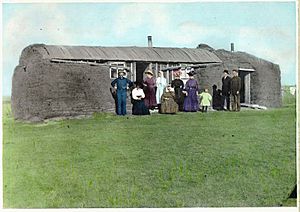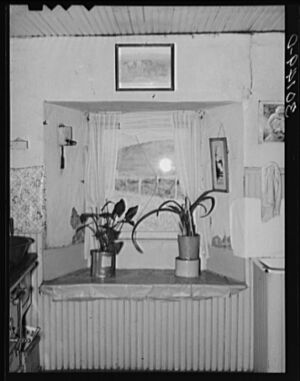Sod house facts for kids


A sod house or soddy was a common type of home built by settlers in the Great Plains of Canada and the United States. This happened mostly in the 1800s and early 1900s. People built sod houses when they didn't have much wood or stone for building. Sometimes, settlers also didn't have enough money to buy regular building materials.
Sod houses were made from thick blocks of prairie grass and soil. This material was free and easy to find in the Great Plains. The roots of prairie grass are much stronger than the grass in a modern lawn. At first, sod was used for animal shelters, fences, and corrals. Later, it became a popular choice for homes.
Building a Sod House
Building a sod house involved cutting patches of sod into shapes, often like triangles. These sod blocks were then stacked to form strong walls. Builders used different ways to make the roof. Sod houses could have normal doors and windows, just like other homes.
Why Build with Sod?
Sod houses were cheaper to build than wooden houses. They also took less time to put together. However, they needed a lot of care to keep them in good shape. Rain could easily damage them, especially if the roof was also made of sod.
Sometimes, settlers put a layer of stucco on the outside walls. This helped protect the sod from the weather. Inside, the walls were often covered with canvas or stucco to make them smoother. There were different styles of sod houses. For example, a type called a semlin was built by Mennonites in Prussia, Russia, and Canada. In Alaska, a similar type of home was known as a barabara.
Famous Sod Houses
Many sod houses are important historical sites today. They show us how early settlers lived. Here are a few examples of notable sod houses or places with sod structures:
- Iceland
- The Skagafjordur Folk Museum in Glaumbær has traditional turf/sod houses. These are built in the burstabær style.
- The Arbaer Folk Museum also shows examples of sod structures.
- Canada
- The Addison Sod House in Saskatchewan is a Canadian National Historic Landmark.
- L'Anse aux Meadows in Newfoundland has recreated Norse sod longhouses. These were built by Norse settlers about 1,000 years ago.
- The Mennonite Heritage Village in Steinbach, Manitoba has a Mennonite-style sod hut called a semlin.
- United States
- The Dowse Sod House near Comstock, Nebraska is a museum. It is listed on the National Register of Historic Places (NRHP).
- The Heman Gibbs Farmstead in Falcon Heights, Minnesota, has a copy of an original 1849 sod house. This site is also NRHP-listed.
- The Sod House (Cleo Springs, Oklahoma) is also known as the Marshall McCully Sod House. It is an NRHP-listed site.
is:Torfbær


